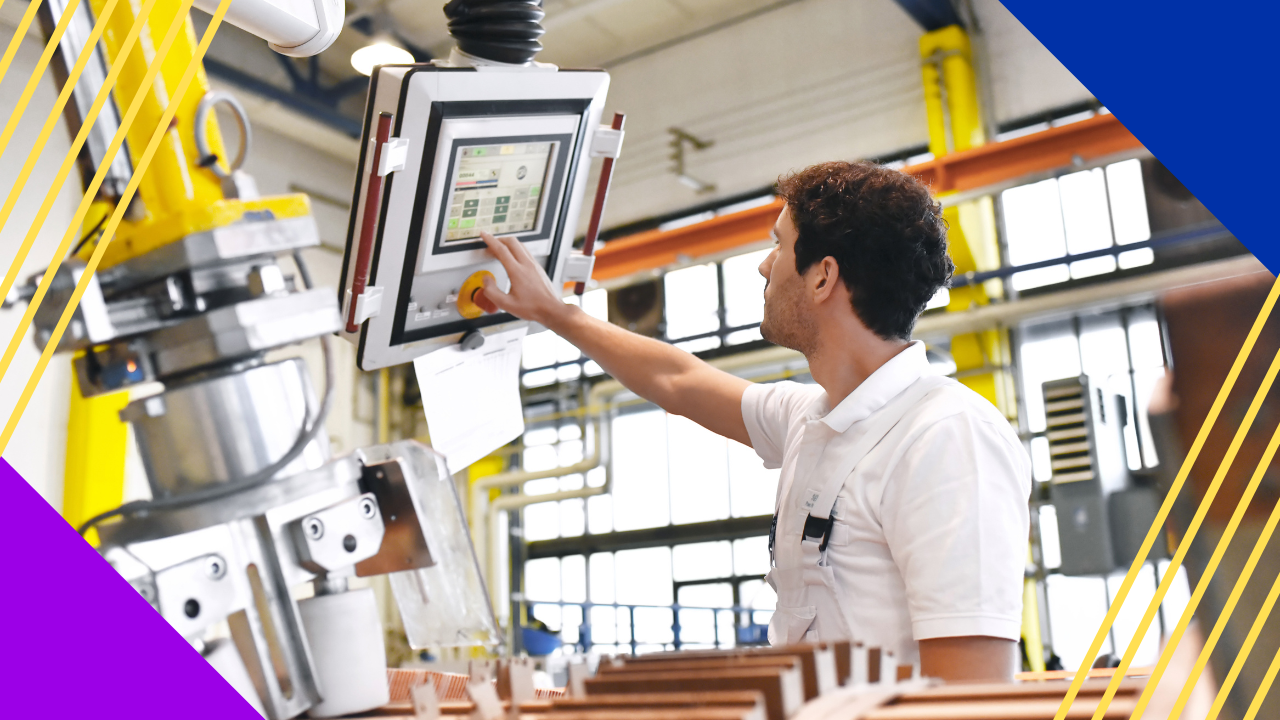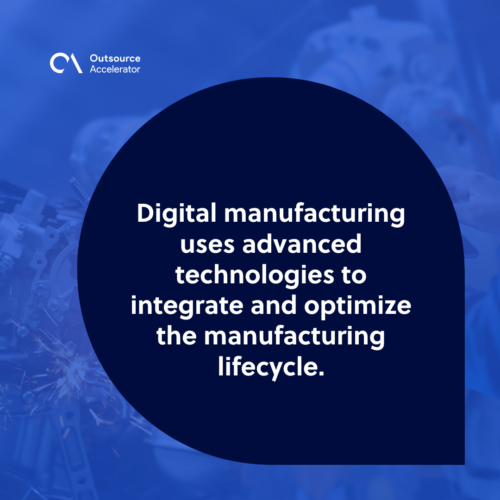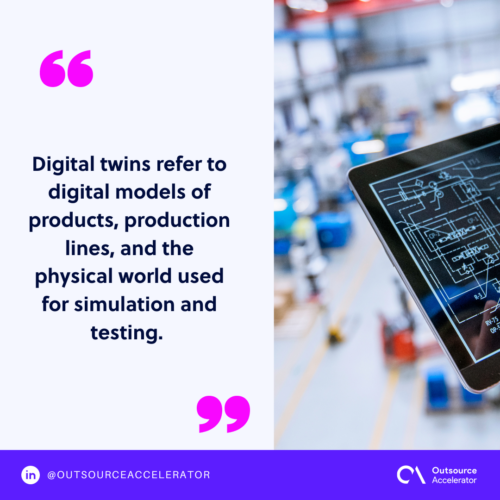A definitive guide to digital manufacturing

Digital manufacturing has revolutionized the industrial landscape. It’s a game-changing approach that has ushered in a new era of efficiency, customization, and sustainability.
Like Industry 4.0 or the Fourth Industrial Revolution, digital manufacturing is an approach that leverages advanced technologies. It is transforming how products are designed, developed, and produced.
According to Mordor Intelligence, the digital transformation market in manufacturing is expected to grow at a CAGR of 18.97% between 2023 and 2028. This exhibits the vast potential of its growth in a billion-dollar industry.
In this comprehensive guide, we will delve into what digital manufacturing is.
Let’s explore its advantages and challenges. Learn about the latest technologies and tools used in the process, and envision the future trends shaping this innovative field.
What is digital manufacturing?
Digital manufacturing uses advanced technologies to integrate and optimize the manufacturing lifecycle. This approach encompasses design, production, supply chain management, and even post-sale support.
The process streamlines the entire manufacturing lifecycle, enabling manufacturers to produce products more efficiently, accurately, and sustainably.

3 types of digital manufacturing
Digital manufacturing can be categorized into three main types. These aspects are based on the different phases in the manufacturing process:
1. Product lifecycle
This type focuses on integrating technology into the entire product development lifecycle. It starts from design, prototyping, and production to maintenance and end-of-life disposal.
Digital manufacturing allows for efficient collaboration, simulation, and validation. Digitalization ultimately shrinks the time and costs associated with physical prototyping.
2. Smart factory
The concept of the smart factory involves the use of connected systems and devices. These technologies can communicate and make data-driven decisions in real time.
Smart factories leverage digital technologies to transform traditional manufacturing operations into highly automated and interconnected systems.
This integration results in real-time monitoring, data analysis, and decision-making. It lessens operational costs and downtime while increasing productivity and quality.
3. Value chain management
This aspect focuses on optimizing supply chain management and logistics using technology. It is used to track inventory, shipments, and production.
Digital manufacturing optimizes the entire value chain by leveraging data analytics. This improves supplier relationships, inventory management, logistics, and customer interactions.
It also enables end-to-end visibility and traceability, decreasing costs and improving operational efficiency and transparency.
Advantages of digital manufacturing
Digital manufacturing offers numerous benefits to manufacturing companies. Here are some of the most significant ones:
Increased efficiency and productivity
Digital manufacturing streamlines production processes, resulting in:
- Reduced production time and costs. Digital production smoothens processes. It eliminates bottlenecks and minimizes downtime, resulting in faster and more cost-effective production.
- Streamlined supply chain management. Real-time data insights enable efficient demand forecasting, inventory management, and distribution. This leads to optimized supply chain operations.
- Improved resource utilization. Digital manufacturing enables smart utilization of resources like raw materials, energy, and labor results in minimal wastage and increased operational efficiency.
Enhanced product customization and complexity
Unlike traditional manufacturing, digital manufacturing can:
- Produce complex geometries. Digital production techniques like 3D printing enable the creation of intricate and customized designs that would have been challenging to produce.
- Enable mass customization and personalized products. With the modern approach, businesses can cater to individual customer preferences. This lets them offer unique and personalized products.
- Respond to changing market demands. Digital manufacturing facilitates quick adaptation to market trends and customer demands. It helps make sure companies stay competitive.
Improved quality and accuracy
Digital manufacturing helps ensure there are:
- Consistency and precision in production. Automation and digitization minimize human errors, resulting in consistent and high-quality products.
- Minimized human errors and defects. Real-time monitoring and data analytics enable early detection of defects. It lessens waste and boosts overall product quality.
- Real-time monitoring and quality control. Digital sensors and data analytics establish continuous monitoring of manufacturing processes. This allows for prompt interventions when deviations happen.

Sustainable manufacturing practices
Digital manufacturing can help with and aims to:
- Decrease material waste and energy consumption. The process optimizes resource utilization. It leads to lower waste and energy consumption and contributes to a greener environment.
- Environmentally friendly production methods. Technologies like 3D printing use less material and energy compared to traditional manufacturing methods. As a result, the approach promotes eco-friendly practices.
- Advancements in recycling and circular economy. Digital manufacturing encourages the use of recyclable materials and the development of circular economic models.
Challenges and limitations of digital manufacturing
Despite the many benefits of digital manufacturing, some challenges still exist. Here are the most significant ones:
Initial setup and implementation costs
Venturing into digital manufacturing can be expensive, making it challenging to implement.
The initial investment required to adopt associated technologies and train the workforce can be substantial. It can be especially challenging for small and medium-sized enterprises (SMEs).
Intellectual property (IP) and security concerns
The use of digital technologies in manufacturing raises concerns about the security of proprietary information. An example would be digital security issues for intellectual property (IP).
While the value of digitized data is enormous, its potential loss can be devastating. This highlights cybersecurity considerations.
Organizations would need to allocate resources to install robust cybersecurity measures to protect sensitive data.
Skill gaps and workforce training requirements
The shift to digital manufacturing needs a capable workforce that can operate and maintain advanced technologies.
Workers would need a broad base of skills, primarily in using digital tools and technologies.
Some companies may struggle to recruit and retain skilled labor, while some businesses may need to procure and handle training to upskill or reskill their workforce.
Regulatory and standardization challenges
Manufacturers often face regulatory compliance or standardization challenges when adopting digital technologies.
As the process continues to evolve, there will be a need for standardized practices and regulations. This is to ensure interoperability and compliance across industries.
An example would be needing to comply with environmental and export regulations. Businesses must also ensure their technologies adhere to standards across different jurisdictions.
Technologies and tools in digital manufacturing
Various technologies and tools are available today that specifically support digital manufacturing. Below are the most widely used ones:
Computer numerical control (CNC) machines
CNC machines are automated devices that use computer programs to control their operation. They are used in manufacturing for precision drilling, cutting, and milling.
These machines automate the operation of manufacturing tools, resulting in precise and efficient machining processes.
3D printing and additive manufacturing
3D printing simplifies product design and production through layer-by-layer material stacking. This method reduces waste and speeds up the manufacturing process.
Additionally, it offers unprecedented design freedom and rapid prototyping capabilities.
Internet of Things (IoT) devices and sensors
IoT devices and sensors help monitor and collect data from machines and other equipment on the assembly line. This data provides insights into machine health and production quality. It can also help improve machine performance.
Artificial intelligence (AI) and machine learning (ML)
AI and ML systems analyze manufacturing data. They predict machine outages, detect manufacturing faults, and enhance consumer insight.
Digital twins and virtual simulation
Digital twins refer to digital models of products, production lines, and the physical world used for simulation and testing. These tools allow for testing prototypes and production processes without physical production.
Digital manufacturing can seamlessly integrate with traditional manufacturing processes to improve efficiency and scalability. Many manufacturing companies now have opportunities to create hybrids that leverage the strengths of both approaches.

Implementation of digital manufacturing
Implementing digital manufacturing involves a systematic approach that includes the following steps:
- Assessment and readiness. Businesses need to evaluate their current manufacturing processes. They must identify which areas can benefit from digitalization and assess their readiness for transformation.
- Technology selection. At this stage, choose the right digital manufacturing technologies and tools based on specific business needs and goals.
- Data integration. This step is where you integrate data from various sources to create a unified and comprehensive digital ecosystem.
- Training and upskilling. Provide employees with the necessary training, upskilling, or reskilling to operate and manage associated technologies.
- Pilot testing. Conduct pilot tests to validate the effectiveness of the digital production implementation.
- Scalability. Gradually scale up the approach’s initiatives across the organization.
Future trends in digital manufacturing
The digital manufacturing revolution is far from over. Many trends indicate further advancement and integration of related technologies.
Here are some of the trends that will shape the future of manufacturing:
Advanced robotics and automation
The use of collaborative robots, also called cobots, will continue to increase. These robots will automate more complex tasks, expanding the reach of automation across production lines.
Cybersecurity considerations in digital manufacturing
Cybersecurity risks continue to be an issue. So manufacturers are increasingly leveraging blockchain technology to secure digital records.
As manufacturing grows more connected, cyber-attacks on manufacturing assets could lead to industrial accidents.
Integration of digital manufacturing with other emerging technologies
Digital manufacturing will increasingly integrate with other emerging technologies. This paves the way for novel products and technological innovation.
For example, bioprinting allows the production of human tissue and organs for medical purposes.
In addition, brain-machine interfaces can enhance human-robot collaboration, enabling more advanced manufacturing capabilities.







 Independent
Independent




